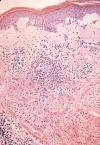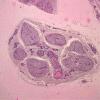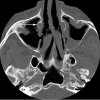An approach to the diagnosis and management of systemic vasculitis
- PMID: 20070316
- PMCID: PMC2857937
- DOI: 10.1111/j.1365-2249.2009.04078.x
An approach to the diagnosis and management of systemic vasculitis
Abstract
The systemic vasculitides are a complex and often serious group of disorders which, while uncommon, require careful management in order to ensure optimal outcome. In most cases there is no known cause. Multi-system disease is likely to be fatal without judicious use of immunosuppression. A prompt diagnosis is necessary to preserve organ function. Comprehensive and repeated disease assessment is a necessary basis for planning therapy and modification of treatment protocols according to response. Therapies typically include glucocorticoids and, especially for small and medium vessel vasculitis, an effective immunosuppressive agent. Cyclophosphamide is currently the standard therapy for small vessel multi-system vasculitis, but other agents are now being evaluated in large randomized trials. Comorbidity is common in patients with vasculitis, including the cumulative effects of potentially toxic therapy. Long-term evaluation of patients is important in order to detect and manage relapses.
Figures














Similar articles
-
One year in review 2017: systemic vasculitis.Clin Exp Rheumatol. 2017 Mar-Apr;35 Suppl 103(1):5-26. Epub 2017 Mar 29. Clin Exp Rheumatol. 2017. PMID: 28375840 Review.
-
Systemic vasculitis.Am Fam Physician. 2011 Mar 1;83(5):556-65. Am Fam Physician. 2011. PMID: 21391523 Review.
-
Childhood systemic vasculitis.Best Pract Res Clin Rheumatol. 2017 Aug;31(4):558-575. doi: 10.1016/j.berh.2017.11.009. Epub 2017 Dec 23. Best Pract Res Clin Rheumatol. 2017. PMID: 29773273 Review.
-
Update on the management of systemic vasculitis: what did we learn in 2009?Clin Exp Rheumatol. 2010 Jan-Feb;28(1 Suppl 57):98-103. Clin Exp Rheumatol. 2010. PMID: 20412713 Review.
-
Systemic vasculitis: a critical digest of the recent literature.Clin Exp Rheumatol. 2013 Jan-Feb;31(1 Suppl 75):S84-8. Epub 2013 Apr 9. Clin Exp Rheumatol. 2013. PMID: 23663686 Review.
Cited by
-
Immunomodulatory treatment of interstitial lung disease.Ther Adv Respir Dis. 2022 Jan-Dec;16:17534666221117002. doi: 10.1177/17534666221117002. Ther Adv Respir Dis. 2022. PMID: 35938712 Free PMC article. Review.
-
Assessment of Skeletal Muscle Perfusion using Contrast-Enhanced Ultrasonography: Technical Note.J Vasc Interv Neurol. 2017 Jan;9(3):41-44. J Vasc Interv Neurol. 2017. PMID: 28243350 Free PMC article.
-
In Vitro Global Gene Expression Analyses Support the Ethnopharmacological Use of Achyranthes aspera.Evid Based Complement Alternat Med. 2013;2013:471739. doi: 10.1155/2013/471739. Epub 2013 Dec 15. Evid Based Complement Alternat Med. 2013. PMID: 24454496 Free PMC article.
-
Beneficial Effect of Rituximab in the Treatment of Esophageal Cancer-Associated Pauci-Immune Glomerulonephritis.Kidney Int Rep. 2016 Jun 29;1(3):131-134. doi: 10.1016/j.ekir.2016.06.004. eCollection 2016 Sep. Kidney Int Rep. 2016. PMID: 29142922 Free PMC article. No abstract available.
-
Narrative Review of Hypercoagulability in Small-Vessel Vasculitis.Kidney Int Rep. 2020 Jan 13;5(5):586-599. doi: 10.1016/j.ekir.2019.12.018. eCollection 2020 May. Kidney Int Rep. 2020. PMID: 32405580 Free PMC article. Review.
References
-
- Watts RA, Scott DGI. Epidemiology of vasculitis. In: Ball GV, Bridges SL Jr, editors. Vasculitis. 2nd. Oxford: Oxford University Press; 2008. pp. 7–21.
-
- Guillevin L, Mahr A, Callard P, et al. French Vasculitis Study Group. Hepatitis B virus-associated polyarteritis nodosa: clinical characteristics, outcome, and impact of treatment in 115 patients. Medicine (Balt) 2005;84:313–22. - PubMed
-
- Ferri C, Greco F, Longombardo G, et al. Antibodies against hepatitis C virus in mixed cryoglobulinemia patients. Infection. 1991;19:417–20. - PubMed
-
- Gordon M, Luqmani RA, Adu D, et al. Relapses in patients with a systemic vasculitis. Q J Med. 1993;86:779–89. - PubMed
-
- Exley AR, Carruthers DM, Luqmani RA, et al. Damage occurs early in systemic vasculitis and is and index of outcome. Q J Med. 1997;90:391–9. - PubMed
Publication types
MeSH terms
Substances
LinkOut - more resources
Full Text Sources
Other Literature Sources

